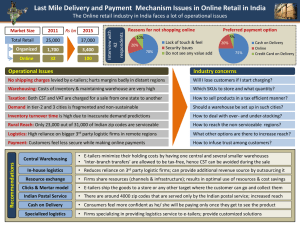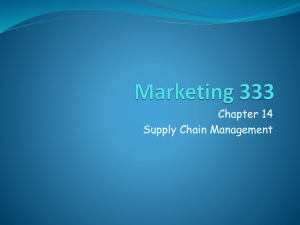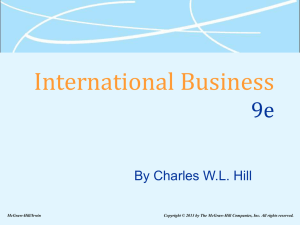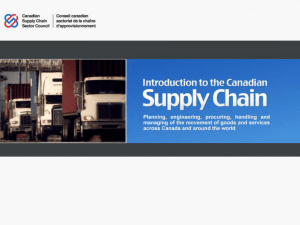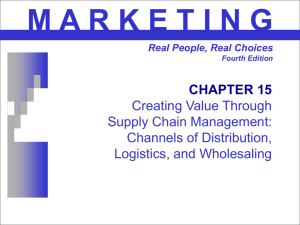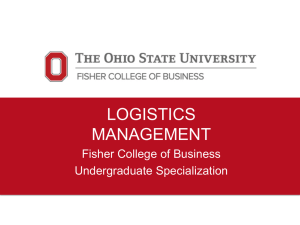創新新思維關懷、分享、永續、安全
advertisement
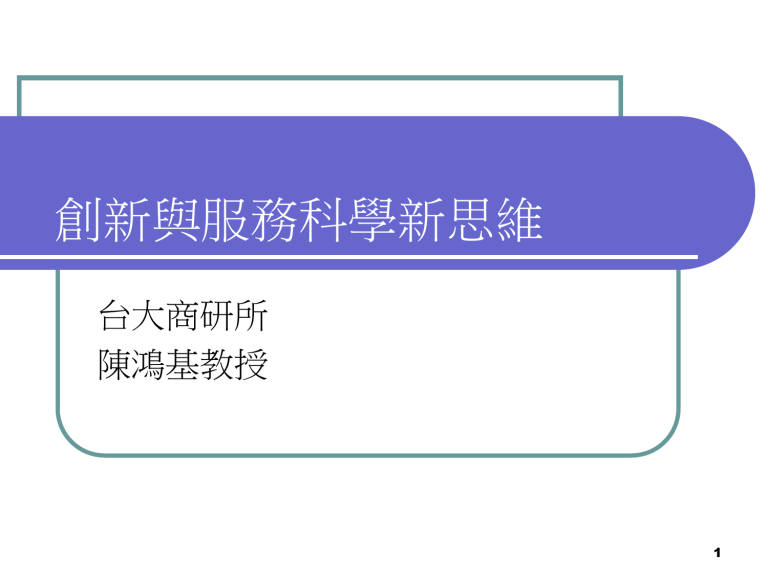
創新與服務科學新思維 台大商研所 陳鴻基教授 1 世界改變的速度 Did you know? The top 10 in-demand jobs in 2010 did not exit in 2004 We are currently preparing students for the jobs that don’t yet exist Using technologies that haven’t been invented In order to solve problems we don’t even know are problems yet 2 Years it took to reach a market audience of 50 million Radio 38 years TV 13 years Internet 4 years iPod 3 years Facebook 2 years Facebook is the 3rd largest country in the world 3 世界工廠 世界市場 4 六項未來全球發展趨勢 5 服務產值的起飛 1900 - 30% employed in the U.S. service sector; 1950 - 62%; 2006- 83% Japan = 85% United Kingdom = 80% China = 36% Taiwan = 76% 6 台灣經濟轉型的概念 台灣發展雙引擎;製造與服務 7 Quickly Adaptive Strategies & Response Capability The Changing Business Operation in Taiwan IT Firms Before the mid–1980s R&D Manufacturing Marketing OEM Original Equipment Manufacturing In the late 1980s Early 1990s R D Manufacturing Marketing ODM Original design Manufacturing After the mid-1990s R D Manufacturing Logistics Marketing ODL/GL Original design logistics/global logistics Early 2000s R D Manufacturing Logistics Marketing IDM/GL innovative design manufacturing/global logistics 8 創造性破壞 打破現況 打破現有營運模式 打破組織僵化 複雜性不僅是威脅,也是機會。風險是需 要被管理的,而不需要迴避。 9 Innovation 文化 人 創意/激勵 顧客 風險/獎勵 需求/回饋 資源 (關係) 分配(整合 維繫) 10 服務的迷思 (傳統) 服務是一種態度 服務是無形的,無法標準化 服務的品質無法保證 服務是免費的,或是低酬勞 服務無法存貨 服務無法外銷 ……………….. 11 服務例子 農民,藝術家,學者 工人 商人 仲介 加值 12 傳統例子 媒人 土地代書 律師,會計師 13 創新的例子 Amazon.com App store, iTune Google Facebook 14 “Service science is just ___<name your discipline>____” A Service System is Complex OR/IE MS Economics & Law CS/AI Multiagent Systems Game Theory Service Management Operations Marketing Engineering Quality Design Information Science (i-schools) MIS Anthropology & Psychology Organization Theory 15 服務創新與服務科學 Make productivity, quality, performance, compliance, growth, and learning improvements more predictable in work sharing and risk sharing (coproduction) relationships. 16 Service as Part of the Car 17 Cars as a Service Business - Innovative thinking 18 租賃服務 GE不再賣飛機引擎 租賃服務 - 保證飛機在天空飛航時數 腳踏車:健康與綠色素求的產品 對消費者的洞察:需求 vs. 擁有 在供應鍊與產品、生產設計上的新思維 3C產品 手機、複印機 PC → NC → NC (no computer!) Apple 19 服務的啟發 對顧客而言,功能才是附加價值的來源, 他們是因使用而付費,未必是為了購買而 付費 產品成為傳達功能的工具 產品本身並非目的 應提供的是功能和使用權(sale of use) 20 服務價值創造 • Goods are commodities • Service sells the product 21 Satisfaction-Productivity Trade-Off in Service • Standardization => Productivity • Customization => Satisfaction • Business moral = can’t do both well, so pick one 22 Customizing for Customers Li & Fung 23 Service & Technology Service is growing fast in the goods sector Why? – Technology (IT) 24 週邊創造價值 – 長尾效應 HP printer HP 碳粉匣 25 創造新模式 Priceline.com 26 Benefits of Technology Decrease costs Increase revenues by improving service 27 創造新營收 7-Eleven 28 服務科學(service Science) 科技對服務創新的 重要性 服務導向的思維協助 科技業創造價值 服務科技化 科技服務化 重要的服務創新主要 來自於與科技的結合, 及商業模式之創新, 而商業模式往往又受 科技的影響,尤其是 網際網路、無線寬頻、 個人電腦等。 高科技產業由於長期 存在製造代工(OEM) 的思維,其附加價值 逐漸減少,如何應用 服務導向的思維,協 助其轉型並創造科技 產業的高價值。 29 A Service-Logic Shift for Service Science Meta Questions? G-D Logic S-D Logic What do firms do this? They produce output, thus emphasis is on efficient production. They produce inputs to service systems, thus emphasis on how to effectively co-produce inputs. How do firms do this? Through operand resources, thus must know how to control people and stuff (static) Through operant resources, thus must know how to collaboratively create apply operant (dynamic) resources. Who do firms do this? To maximize shareholder wealth, thus must know how to increase profit, cash flow and share price. To build mutually beneficial exchange relationships that enhance mutual wellbeing for the firm and stakeholders i.e., serve all stakeholders. What scientific concepts and tools are dominant? Optimization Models; Controlled Experiments; Static Equilibrium; Logic of Justification. Evolutionary Computing; Ethnography; Complex Adaptive Systems; Logic of Discovery 30 Difficult Conceptual Transitions Good-Dominant Concepts Transitional Concepts Service-Dominant Concepts Goods --------------------------> Products -----------------------> Feature/attribute -------------> Value-added ------------------> Profit maximization ----------> Price ----------------------------> Equilibrium systems ---------> Services ------------------------> Offerings -----------------------> Benefit --------------------------> Co-production -----------------> Financial Engineering -------> Value delivery -----------------> Dynamic systems ------------> Supply chain ------------------> Value-Chain -------------------> Service Experiences Solution Co-creation of value Financial feedback/learning Value proposition Complex adaptive systems Value-creation network/constellation To market ----------------------> Integrated Marketing Communications -------------> Market to -----------------------> Product orientation ----------> Market Orientation -----------> Promotion ----------------------> Dialog Market with Service-Dominant Logic (Consumer and relational) 31 雲端運算重塑資訊產業樣貌 32 智慧型手機 - APPs/Accessories 33 數位匯流發展驅動力 技術推動 資訊技術 Internet/IP 寬頻網路 數位化 終端裝置 需求拉動 快速服務 資訊豐富及多媒體 websites 使用者創作的內容 及自我表現 資訊分享與合作 Uploading and downloading 34 醫療照護創新趨勢 從疾病到健康 從“醫院centric”到“病人centric” 個人化(Personalization) 預測 (Prediction) 預防(Prevention / disease preemption) 病人責任(Patient Responsibility) Source: G. Steven Burrill (2010) presented on Baybio 2010 35 演變中的創新策略 創新的本質 拓展至服務領域,包括非市場服務(如公共部門服務) 比R&D更廣泛的創新,例如設計、行銷、組織創新 應用於社會議題 - e.g.氣候變遷、老年化社會等 創新的落實 越多不同跨界的交流/互動:領域、地理與機構 成本、競爭與風險的期望,促進更多開發/合作 Source: The QECD Innovation Strategy (2010) 36 創新決定因素: 數位時代的開發式創新 技術與服務創新:硬體與軟體之系統整合 制度創新:解除管制、消除創新障礙 技術融合、界線模糊 跨領、跨界 Social network 生態系統、創新平台 創新 新思維 關懷、分享、永續、安全 37 Q&A 38


